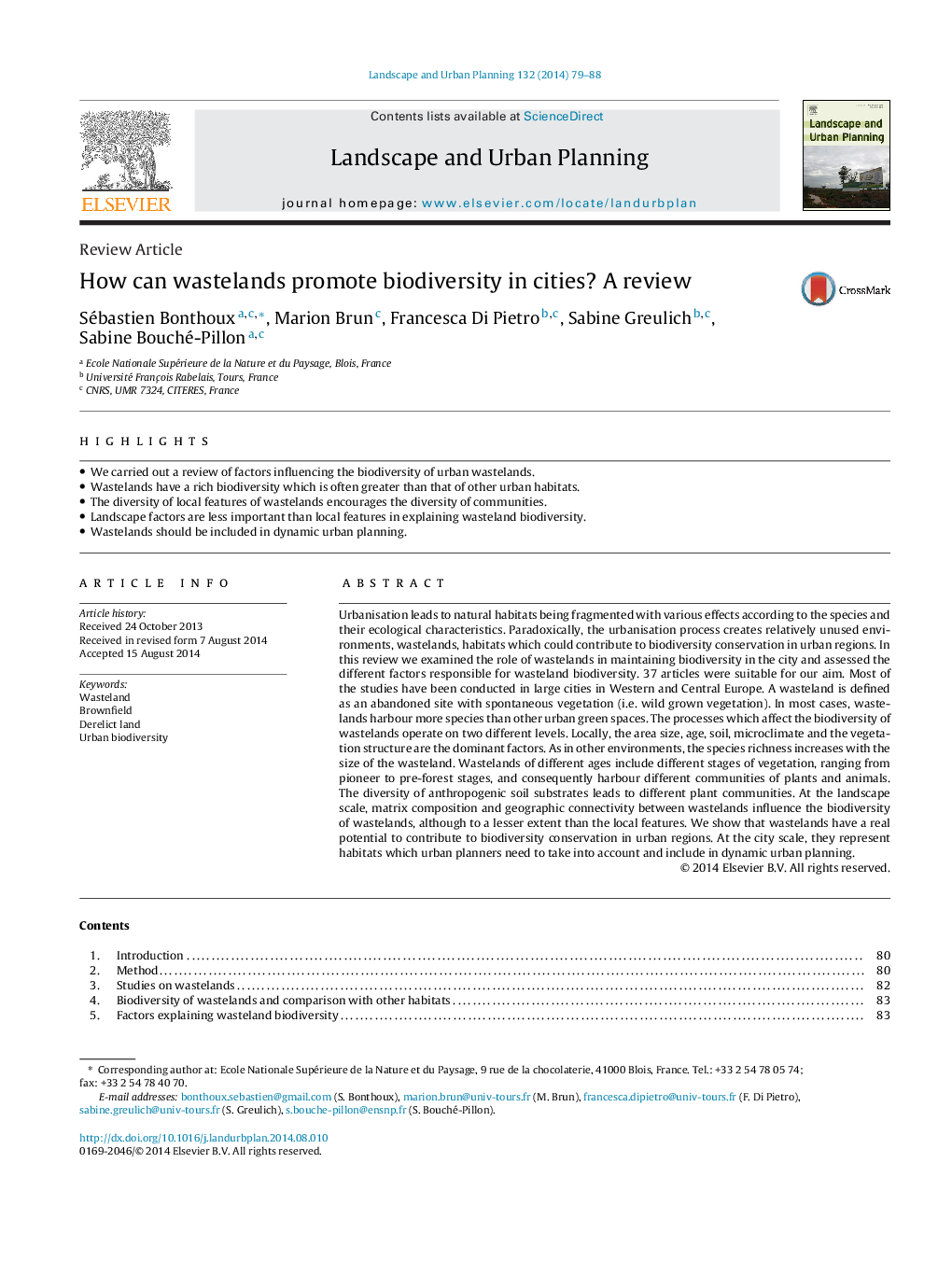| کد مقاله | کد نشریه | سال انتشار | مقاله انگلیسی | نسخه تمام متن |
|---|---|---|---|---|
| 7461241 | 1484626 | 2014 | 10 صفحه PDF | دانلود رایگان |
عنوان انگلیسی مقاله ISI
How can wastelands promote biodiversity in cities? A review
ترجمه فارسی عنوان
چگونه می توان تمیز کردن مناطق تنوع زیستی را در شهرهای تسهیل کرد؟ بازنگری
دانلود مقاله + سفارش ترجمه
دانلود مقاله ISI انگلیسی
رایگان برای ایرانیان
کلمات کلیدی
خالی براونفیلد، سرزمین معیوب، تنوع زیستی شهری،
ترجمه چکیده
شهرنشینی منجر به ایجاد زیستگاه طبیعی می شود که با توجه به گونه ها و ویژگی های اکولوژیکی آن، با تأثیرات مختلفی تجزیه می شود. به طور متناقض، فرآیند شهرسازی، محیط های نسبتا استفاده نشده، مناطق بیدرنگ، زیستگاه ها را ایجاد می کند که می توانند در حفاظت از تنوع زیستی در مناطق شهری کمک کنند. در این بررسی، نقش تمایلات مختلفی را در حفظ تنوع زیستی در شهر مورد بررسی قرار داده ایم و عوامل مختلفی را برای تنوع زیستی خشکسالی ارزیابی شده است. 37 مقاله برای هدف ما مناسب بودند. بیشتر مطالعات انجام شده در شهرهای بزرگ اروپای غربی و مرکزی انجام شده است. فضایی است که به عنوان یک محوطه رها شده با پوشش گیاهی خودبه خود (به عنوان مثال گیاه شناخته شده وحشی) تعریف شده است. در اغلب موارد، آبخیزداری دارای گونه های بیشتری از فضای سبز شهری است. فرایندهایی که بر تنوع زیستی زمین های بتنی تاثیر می گذارند، در دو سطح مختلف عمل می کنند. به طور محلی، اندازه مساحت، سن، خاک، محیط اطراف و ساختار گیاهی، عوامل مهمی هستند. همانطور که در محیط های دیگر، غنای گونه ای با اندازه بوته نیز افزایش می یابد. حوضچه های مختلف سنین شامل مراحل مختلف پوشش گیاهی می باشد، از ابتدا تا مراحل پیش از جنگل، و در نتیجه بندر جوامع مختلف گیاهان و حیوانات. تنوع زمینهای انفجاری خاک منجر به جوامع گیاهی مختلف می شود. در مقیاس چشم انداز، ترکیب ماتریس و اتصال جغرافیایی بین حوضچه ها، بر تنوع زیستی حوضچه ها تاثیر می گذارد، هرچند به میزان کمتری نسبت به ویژگی های محلی. ما نشان می دهیم که مناطق باتلاق دارای یک پتانسیل واقعی برای حفاظت از تنوع زیستی در مناطق شهری هستند. در مقیاس شهر، آنها نمایانگر زیستگاه هایی هستند که برنامه ریزان شهری باید در نظر بگیرند و در برنامه ریزی شهری پویا قرار گیرند.
موضوعات مرتبط
علوم زیستی و بیوفناوری
علوم کشاورزی و بیولوژیک
بوم شناسی، تکامل، رفتار و سامانه شناسی
چکیده انگلیسی
Urbanisation leads to natural habitats being fragmented with various effects according to the species and their ecological characteristics. Paradoxically, the urbanisation process creates relatively unused environments, wastelands, habitats which could contribute to biodiversity conservation in urban regions. In this review we examined the role of wastelands in maintaining biodiversity in the city and assessed the different factors responsible for wasteland biodiversity. 37 articles were suitable for our aim. Most of the studies have been conducted in large cities in Western and Central Europe. A wasteland is defined as an abandoned site with spontaneous vegetation (i.e. wild grown vegetation). In most cases, wastelands harbour more species than other urban green spaces. The processes which affect the biodiversity of wastelands operate on two different levels. Locally, the area size, age, soil, microclimate and the vegetation structure are the dominant factors. As in other environments, the species richness increases with the size of the wasteland. Wastelands of different ages include different stages of vegetation, ranging from pioneer to pre-forest stages, and consequently harbour different communities of plants and animals. The diversity of anthropogenic soil substrates leads to different plant communities. At the landscape scale, matrix composition and geographic connectivity between wastelands influence the biodiversity of wastelands, although to a lesser extent than the local features. We show that wastelands have a real potential to contribute to biodiversity conservation in urban regions. At the city scale, they represent habitats which urban planners need to take into account and include in dynamic urban planning.
ناشر
Database: Elsevier - ScienceDirect (ساینس دایرکت)
Journal: Landscape and Urban Planning - Volume 132, December 2014, Pages 79-88
Journal: Landscape and Urban Planning - Volume 132, December 2014, Pages 79-88
نویسندگان
Sébastien Bonthoux, Marion Brun, Francesca Di Pietro, Sabine Greulich, Sabine Bouché-Pillon,
